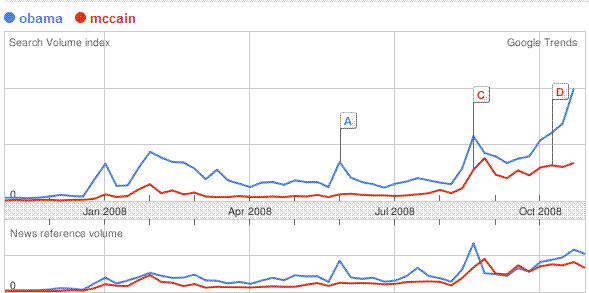Google Predicted the Election
As I pointed out in my book “Ron Paul Revolution: History in the Making” Google trends is much more accurate measure of the public opinion than limited polls. Since Google searches are what people are really interested in and can’t be swayed by the wording of the questions it’s more truthful. Also Google searches tracks every search so it is not as prone to sample bias.
I believe the polling methods used are part of the reason the Republican party failed. And even though the election looks like a big win for Obama and the Democrats I suspect they are missing very important aspects of what happened. Looking at people as groups rather than individuals hides what is really going on. People act as individuals not groups. Individuals have very different needs and desires. The entire election process forces people to pick a watered down version of what they really want.
There are enough people who don’t vote to win an election. That is the unserved long tail majority. In politics it might be possible to ignore the real majority by fighting over pieces of the small pie but businesses can’t do that and succeed. That huge group of potential customers are fuel for disruptive innovation. Any company that reaches that untapped group will jump to the industry leader.
Old methods of polling and marketing research won’t find these hidden non-buyers. Predictive Innovation can show you the untapped markets and how to reach them. As more distributed tools like Google Trends become available it becomes more important to learn how to use the Predictive Innovation Method.
Upgrade Destroys My Site
While trying to upgrade my site to the newest version of Word Press the entire site was wiped out. Fortunately the articles are still in the data base but all my rich content like MP3 and and images and PDFs are now gone. I also lost all the customer themes and plugins.
What about a backup? Tried the restore and it didn’t work. So I will have to completely start over with the website.
Why Six Sigma Fails Detroit
Michigan desperately needs innovation to be competitive. When Japan started using Statistical Process Control (SPC) now known as Six Sigma, it was a competitive differentiator. In other words Japanese auto makers used quality and lean process as an innovation. Detroit has been feverishly implementing Six Sigma but they are still losing ground to the Japanese and now the Koreans and soon to be China. Why?
Six Sigma is a great thing but doing it as a “me-too”? only creates commoditization. Worse yet, the entire process of Six Sigma is about doing the same thing cheaper and cheaper. That leaves you in a death spiral to the lowest priced product, and little or no profits. Does that sound familiar?
Detroit, Michigan and the USA in general need innovation. Everyone knows that but almost no one is really doing it. The main reason is they don’t know how. What if innovation could be as predictable and systematic as Six Sigma? What if a company could create practical, profitable innovations on demand? Does that sound fantastic? Impossible?!? It is fantastic and it’s absolutely possible.
Predictive Innovation makes innovation:
- Efficient
- Low-Risk
- Controllable
- Repeatable
- Competitive
- Reliable
- Just-In-Time
Rather than looking at innovation as a magical creative activity it uses the very well defined study of System Theory and new breakthroughs in Information Theory to create a step-by-step process for innovation. How systematic is it? How about knowing there are 7 specific elements to innovate in any product or service and there are 15 types of alternatives for each element? When you realize that, you are guaranteed 105 innovations targeted precisely to your business needs and your customer’s desires.
When you use Predictive Innovation you can create an innovation strategy that causes your profit margins to increase overtime, risks to decrease and eliminate the threat of any competition.
Predictive Innovation has been used to create entire families of products, increase the value of investments, and solve seemingly impossible problems. It’s been applied to manufacturing, software, medicine, marketing, security, business strategy, politics, and entertainment.





 Predictive Innovation Training
Predictive Innovation Training Predictive Innovation: Core Skills Book
Predictive Innovation: Core Skills Book RoundSquareTriangle.com
RoundSquareTriangle.com